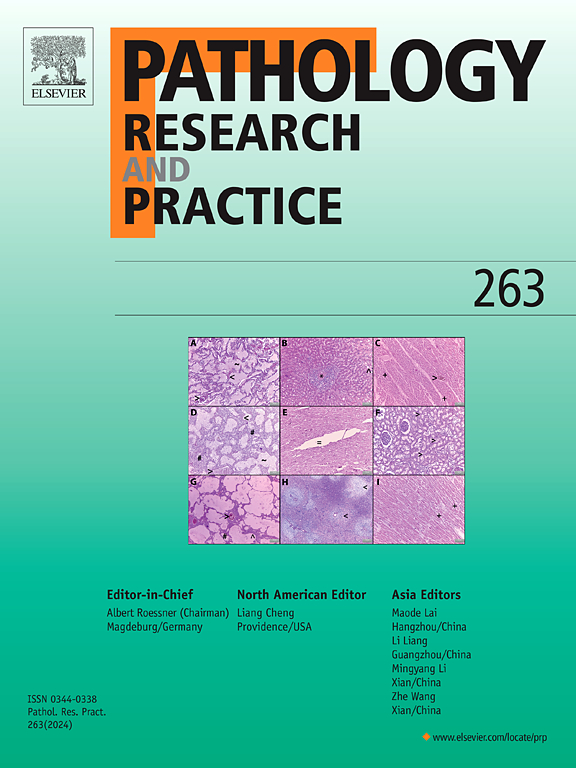AXL in cardiovascular diseases: Pathophysiological insights and clinical perspectives
IF 2.9
4区 医学
Q2 PATHOLOGY
引用次数: 0
Abstract
Cardiovascular diseases (CVDs) remain the leading cause of mortality worldwide, posing significant challenges to global health systems. Among the diverse molecular regulators implicated in CVD pathogenesis, AXL (AXL receptor tyrosine kinase)—a member of the receptor tyrosine kinase family that includes Tyrosine-protein kinase receptor TYRO3, AXL receptor tyrosine kinase, and MER proto-oncogene tyrosine-protein kinase (collectively referred to as the TAM family)—emerges as a pivotal player with multifaceted roles. This review comprehensively explores the biological functions of AXL in cardiovascular systems, emphasizing its dualistic nature in regulating processes such as apoptosis, inflammation, oxidative stress, and vascular remodeling. AXL exerts context-dependent effects across various cardiovascular cell types, including endothelial cells, vascular smooth muscle cells, macrophages, and cardiomyocytes, influencing key pathological mechanisms underlying atherosclerosis, hypertension, myocardial ischemia-reperfusion injury, aneurysm rupture, and other cardiovascular conditions. Notably, AXL-mediated signaling through the GAS6/AXL axis reveals protective effects in certain settings while exacerbating damage in others. These findings underscore the complexity of AXL's role in cardiovascular health and disease. The review also highlights the therapeutic potential of targeting AXL in CVDs, discussing current challenges in designing cell-type-specific and context-sensitive interventions. By integrating emerging evidence, this review aims to advance understanding of AXL's role in cardiovascular pathology and inform the development of innovative, targeted therapeutic strategies.
心血管疾病中的AXL:病理生理学见解和临床观点
心血管疾病(cvd)仍然是全球死亡的主要原因,对全球卫生系统构成重大挑战。在与CVD发病机制相关的多种分子调节因子中,AXL (AXL受体酪氨酸激酶)——受体酪氨酸激酶家族的一员,包括酪氨酸-蛋白激酶受体TYRO3、AXL受体酪氨酸激酶和MER原癌基因酪氨酸-蛋白激酶(统称为TAM家族)——在多方面发挥着关键作用。本文综述了AXL在心血管系统中的生物学功能,强调其在调节细胞凋亡、炎症、氧化应激和血管重构等过程中的二重性。AXL在多种心血管细胞类型中发挥上下文依赖效应,包括内皮细胞、血管平滑肌细胞、巨噬细胞和心肌细胞,影响动脉粥样硬化、高血压、心肌缺血再灌注损伤、动脉瘤破裂和其他心血管疾病的关键病理机制。值得注意的是,通过GAS6/AXL轴的AXL介导的信号在某些情况下显示出保护作用,而在其他情况下则加剧了损伤。这些发现强调了AXL在心血管健康和疾病中作用的复杂性。该综述还强调了靶向AXL在心血管疾病中的治疗潜力,讨论了当前设计细胞类型特异性和环境敏感干预措施的挑战。通过整合新出现的证据,本综述旨在促进对AXL在心血管病理中的作用的理解,并为创新的靶向治疗策略的发展提供信息。
本文章由计算机程序翻译,如有差异,请以英文原文为准。
求助全文
约1分钟内获得全文
求助全文
来源期刊
CiteScore
5.00
自引率
3.60%
发文量
405
审稿时长
24 days
期刊介绍:
Pathology, Research and Practice provides accessible coverage of the most recent developments across the entire field of pathology: Reviews focus on recent progress in pathology, while Comments look at interesting current problems and at hypotheses for future developments in pathology. Original Papers present novel findings on all aspects of general, anatomic and molecular pathology. Rapid Communications inform readers on preliminary findings that may be relevant for further studies and need to be communicated quickly. Teaching Cases look at new aspects or special diagnostic problems of diseases and at case reports relevant for the pathologist''s practice.

 求助内容:
求助内容: 应助结果提醒方式:
应助结果提醒方式:


